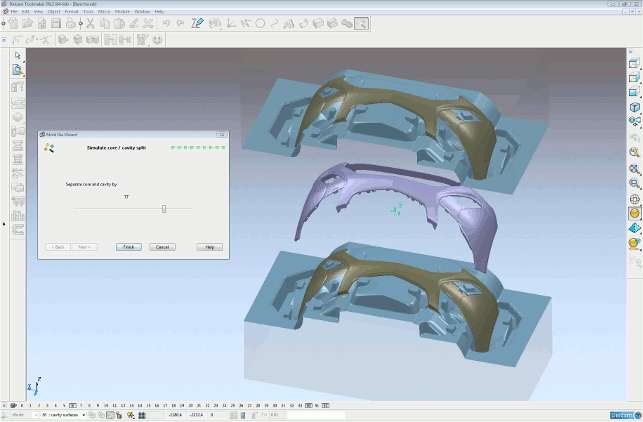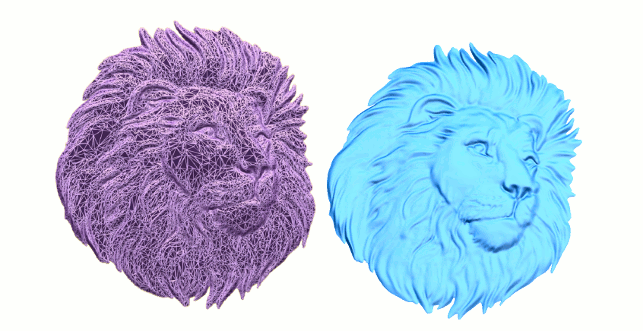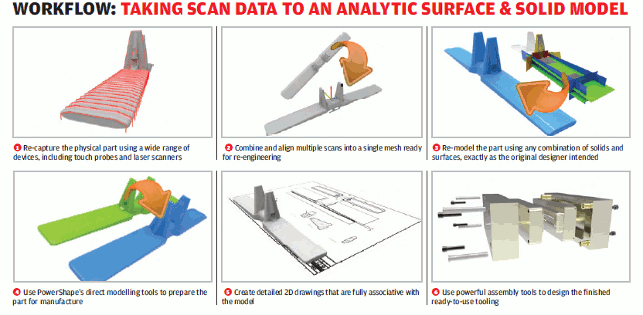Delcam has been in the 3D design industry news a lot of late. Its acquisition and subsequent announcements from its new parent company, Autodesk, have seen its profile raised higher than ever before.

PowerShape Pro now includes some rather nifty core and cavity design tools
Much of that hype has concentrated on the company’s range of CAM products — from the high-end surface-based machining tools in PowerMill to the production CAM of FeatureCAM and into the more specialised areas with PartMaker.
In the design world, the company’s name and reputation is focused on enabling users (typically in the mould and die design process, but by no means limited to it) to work with the geometry they have, adapting, editing and preparing it for production readiness.
This means that PowerShape Pro has always been comfortable working with a mix of solids and surfaces, without really favouring one over the other (as is common with many systems).
In the last few years, Delcam has gained a lot of expertise, not only in working with polygon data or meshes, but also the process and ins and outs of capturing that data.
While much of that work was done to support the development of its PowerInspect system, the last few release cycles have seen more and more capability to mix not only solids and surfaces, but also polygon meshes, point clouds and much more into the core of PowerShape.
So let’s take a look at some of the highlights of this release, starting with how PowerShape can now work with that point cloud and mesh data and also assist in its capture.
Point to surfaces & solids
With the previous major release (PowerShape Pro 2013), Delcam added support to use laser scanning devices directly within the application. This type of task is typically handled by a third party application, but not in this instance.
PowerShape Pro gained the ability to plug in commonly found hardware (from Romer, Faro, Creaform, Nikon, Perception, etc.), capture the data, clean and repair it resulting in a point cloud (and associated mesh) from which analytic surfaces and solid features can be reconstructed.
The 2014 release builds on this foundation to make the reconstruction process more intelligent and efficient. As with many of Delcam’s tools it follows a well defined process that guides, rather than prescribes, the user through the process.
The first step is to perform an analysis of the point cloud. This is based on an algorithm that looks for curvature as well as other, more structured forms, such as planar faces, cylindrical features, pockets, fillets and such.
The end result is a point cloud-based mesh that’s segmented into regions that define each surface or feature type.
You then use the tools built into PowerShape Pro to construct each of these features. The odds of automating such work is pretty much limited to the realms of a demo, the system instead relies on providing tools to quickly add in the features that are easily identified.
Once all the geometry is in place, the system provides tools to manipulate the surfaces, trim/extend where needed and join them up.
All throughout the process, tools are given to measure against the underlying points or polygons to make sure you’ve got things to the correct dimensions.
Complex point clouds
Alongside the new tools to deal with prismatic parts, there’s also a more complex type of geometry that can now be worked with in PowerShape Pro.
These are typically scanned items that feature heavy detailing, either from scanned geometry, from imported STLs and the like, or from Delcam’s ArtCAM decorative design system.

PowerShape’s new Shrinkwrap tools let you drape a surface over complex polygon meshes
These new Shrink-wrap tools let you drape a NURBS surface patch (or set of) over the polygon mesh so that it can, if required, be incorporated into models that also feature solids and surfaces.
Again, PowerShape Pro has had this type of tool for some time, but the process is now more efficient and requires fewer workarounds.
Core & cavity design
Just as with the points to solids workflow, another area to get more intelligence is the design of cores and cavities for mould and die design.
This is something that PowerShape Pro has always been able to do, but the new tools make it more automated where possible.
The workflow begins with the model of the part in question. The main draw direction is identified on the model and an analysis is quickly run to find which surfaces need to relate to the core, and to the cavity and those where a slider action or an insert is required.
Each is automatically assigned to the group that it needs to be, where possible. Animation and undercut shading tools are available to preview the mould’s action.
Of course, while many other systems provide this type of tool, Delcam adds in some of its special magic to make the process more suited to working with complex forms.
Typically, there are always going to be faces that bridge the parting line and need to be split, or their assignment is ambiguous. PowerShape Pro makes light work of the process as you split the faces, reassign the new forms to the correct ‘side’ and continue around the model.
Solid modelling
While PowerShape Pro’s reputation has, perhaps, been built on its ability to work with complex surfaces, the last four years have seen the system gain more power when it comes to working with solid geometry.
A couple of years ago, Delcam adopted the Parasolid modelling kernel and the developments since have shown how the company is applying its unique perspective to the solid modelling process.
This release continues this with more direct modelling tools that allow changes to be made quickly and efficiently.
It also sees the incorporation of more feature/history type tools to create the forms that its customers need to do on a daily basis, but might struggle to do in more mainstream applications.
A perfect example is the ability to sketch out the profile of a slot then wrap that slot around the geometry it’s required to be cut into or built out from.
These types of features would typically need several steps and features, but can now be accomplished with ease. You sketch the profile on a plane normal to the form (typically a cylinder, perhaps in a shaft), then the system wraps it and creates nice clean surfaces to build the form.
Conclusion
There’s much talk about the growing use of reverse engineering technology. At the entry level, prices are dropping (as evidenced by the 3D Systems Sense we looked at in the May) and the whole market is moving towards more accessible hardware.
What’s rarely discussed is the need to be able to do something constructive with that data once you’ve got it.
Additional tools are often needed to prep the data to transfer into a more traditional 3D design system. PowerShape Pro circumvents this by enabling the whole workflow to be conducted in a single system, without the need for additional investment.
When combined with the system’s existing tools (that are enhanced with each release) for handling surfaces, solids and moving them through the design to manufacture process, you end up with an incredibly powerful system that’s worthy of investigation by many.
| Product | PowerShape Pro 2014 |
|---|---|
| Company name | Delcam |
| Price | on application |







